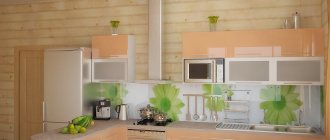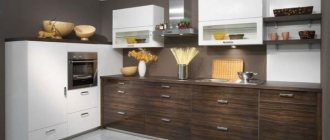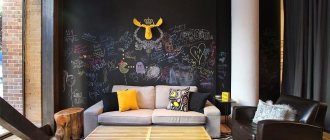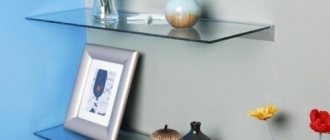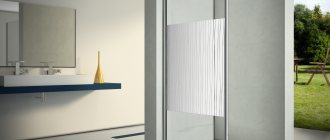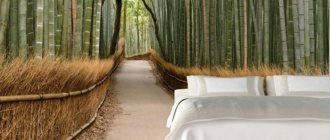Due to the excellent degree of light transmission, glass blocks visually expand the space, making even the most secluded corners of the room much lighter. In addition, this material scatters direct sunlight well, which in itself plays a significant role in saturating the room with daylight, giving softness and comfort when relaxing in it. Glass blocks and walls built with them can withstand significant temperature changes, from -40 to hot + 50o C.
The glass blocks used in the interior do not burn, they are extremely durable and do not require additional care. Glass blocks are an excellent modern choice for the design and renovation of any room.
During the Soviet period, blue-green glass blocks were known to everyone: they were used to decorate bathhouses, canteens, hospitals and staircases. Today, glass blocks in the interior are again a popular material, but the possibilities for their use have become greater. These elements are used for both finishing and decorative purposes, because they shimmer beautifully in the light and create a cozy atmosphere. The glass blocks, photos of which you will see in this article, combine aesthetics and high quality.
What are glass blocks?
Essentially, it is a hollow cube or box with walls of a certain thickness and a sealed cavity. The walls are hot-welded glass bricks. Today you can find not only square blocks with standard dimensions of 24 by 24 or 19 by 19 cm, but also oblong glass models. The variety of modern glass blocks is due to the fact that their production is no longer regulated as strictly and strictly by GOST as it was in the USSR.
The average thickness of glass in blocks is up to 1 cm, and the thickness of the blocks themselves can vary from 5 to 10 cm. The weight of glass blocks is determined by their size and can range from 2 to 5 kg.
The air gap in modern blocks can be filled with different contents: floral compositions, lighting with a 3D effect, mother-of-pearl, marine installations, stones, etc. In appearance, glass blocks are not only transparent or plain colored, but also patterned, with graphics, stained glass or ornaments applied.
Photos on the Internet help in getting to know the types of glass bricks in the interior. However, even hourly monitoring of the Network will not give a complete picture of the classification of glass blocks. So, they can be with a corrugated or convex surface, half-shaped, with rounded edges and even angular modifications. There are also special end blocks. Many of these models are needed just to make original columns and partitions from glass blocks.
Advantages of glass blocks for interior design
Almost every designer in his life at least once worked with glass bricks and posted photos of them in the interior. Why is this seemingly very simple material so popular? It turns out that glass blocks have a lot of advantages, not counting their reasonable cost.
- Noise insulation. The air gap in such a glass “sandwich” allows you to delay noise by 60-70%. Therefore, blocks are often used in bathrooms and kitchens to prevent the sound of water from reaching neighboring rooms.
- High light transmittance. Transparent block models transmit 70-90% of light rays, colored ones - 50-70%, and matte ones - up to 50%. This is a high rate of light transmission, so glass blocks help save on artificial lighting in the house. In addition, the light can be either directional or scattering.
- Privacy of space. The blocks are made of thick glass, which blurs the outlines. With this material you are reliably protected from prying eyes without any curtains or blinds.
- Strength and thermal conductivity. In terms of the first indicator, glass blocks can be easily compared with bricks: to break such material, you need to resort to a sledgehammer. According to the second criterion, due to the air layer, the blocks bypass the brick, because retain heat much better.
- Resistance to aggressive environments. Glass blocks are not afraid of moisture, fungus, scratches and rust, and can also easily withstand powerful temperature changes.
- Versatility. Glass blocks are good for literally everything. They are in demand in construction, finishing work, furniture production and decoration. The imagination of technologists and designers is limitless, so glass is suitable for zoning an apartment, lighting a house and visually expanding space. You can work with blocks not only in the interior, but also in the exterior. This means that correctly selected blocks will give any room a stylish and harmonious look.
- Rich assortment. Today's glass blocks have dozens of shapes and textures. Glass blocks in the interior can be plain and multi-colored, matte and shiny, smooth and wavy, diamond and grainy. Moreover, each model gives its own unique lighting effect in space. So for a room in any style, you can make unique walls from glass blocks or choose an elegant piece of furniture.
- Easy care. You can wipe the glass blocks many times with any detergent (for example, window cleaner) or get by with cleaning with a regular damp cloth. Repairing a glass block structure is also easy: simply replace the damaged element.
- Environmentally friendly and non-flammable. The blocks are made from natural recyclable material; they protect against dust and dirt from the street, do not emit harmful substances into the air and do not support combustion. By the way, the blocks can easily heat up without melting or cracking for a whole hour.
- No need for additional finishing. When a wall, floor or partition is ready, there is no need to paint or plaster it.
What to consider when incorporating glass blocks into your interior?
- Due to the large weight of the blocks, you can easily overload the room in terms of engineering and destroy the floor, or even the walls. Therefore, do not use glass blocks on surfaces larger than 15 square meters. m.
- Glass blocks cannot be cut. It is necessary to select optimal sizes and shapes in advance, adapting to production standards.
- A wall made of glass blocks cannot have wiring inside or be decorated with additional decor, since driving a nail or screwing a screw into such a surface will not work.
- Glass blocks cannot be used to create load-bearing structures. First of all, this is a material for finishing and decoration, so it is not designed for heavy loads.
- The harmonious ratio of glass blocks to other finishing materials is 1 to 10, but this rule does not apply to the bathroom and bathtub. Glass goes well with metal, wood, fabric base, etc. Unless you want to create an icy cold cave (like a hospital room), don't forget to also play with color contrasts by adding warm, bright tones.
Where and when are glass blocks used?
- For decoration and construction of interior walls. This is especially true for apartment redevelopment or in the design of a public lobby or office corridor. Glass blocks help to zone and lighten the space, and in general the glass wall looks original. For comfort, it is better to combine glass blocks with different materials in warm colors (plasterboard or brickwork). Glass blocks precisely recessed into the wall will not transmit too much light, but will reflect it beautifully, creating a play of shadows. A separate design solution is a glass bay window, a rounded or simply figured wall with inserts. If such a wall forms a free niche, you can make an area in it for souvenirs or various decorative items.
- When creating partitions. It is in this version that glass blocks are popular in the bathroom, and any photo on the Internet will confirm this. With different widths, heights and patterns, it is especially convenient to make a glass partition in a combined bathroom. The material goes well with tiles, does not deteriorate from moisture, is easy to clean and does not grow moldy. Frosted glass blocks will allow you to create a more intimate area, i.e. a separate beautiful shower stall of the desired shapes and sizes. However, the bathroom is not the only place in whose interior a glass partition looks appropriate. So, with its help you can divide the kitchen into a dining room and a work area, as well as the entire studio apartment into areas for relaxation, work and receiving guests. Partitions can be arched, round and oval, trapezoidal and even pyramidal. They can also be “stuffed” from the inside with LEDs, adding soft light for relaxation, for example, in the bedroom.
- In window decoration. Frosted and transparent windows can be inserts in swimming pools and bathrooms. For decoration, such a window with a mosaic pattern or stained glass film can be made in the living room, decorating the opening with light curtains. Finally, a decorative window of any shape can connect the kitchen and bathroom or the dining room and hallway. Glass blocks allow you to increase the light transmittance of a window, but the air in such structures circulates poorly, so it quickly becomes stuffy. But a decorative window in the bathroom can additionally become a base for a mirror or shelves.
- When laying floors. Glass blocks are very durable, and if you take large matte models with a rough surface, you can get a high-quality floor covering. The best design option would be to put lighting under it. Glass floors are only undesirable in bathrooms, kitchens and hallways: dirt from the street or splashed water can make the surface very slippery.
- When laying the roof. Glass blocks are often built into the gable areas of roofs to illuminate the attic or attic. In private homes, this solution helps to create a greenhouse and winter garden with natural light. And if you make a glass roof with a glass floor, you can achieve the effect of a completely airy and light space.
- For creating furniture and decorative items. Practical glass can become the basis of a kitchen “island”, a panel, a luminous bar counter, a console under the sink, a cabinet dining table and even a coffee table. However, it is worth considering that such furniture is desired on rigid frames, so it will not be possible to move it. Glass blocks can be used to decorate kitchen splashbacks, doorways and mirrors. These elements are also used to make steps for podiums or stairs and decorative fireplaces.
Compatibility of glass blocks with other materials
Since glass blocks are actively used for the construction of external and internal walls, they are perfectly combined with traditional building materials such as concrete and brick. This makes it possible to lighten wall structures made from these materials during the construction of country houses, winter gardens, bathhouses and other buildings. In addition to brick and concrete, glass blocks are combined with plasterboard to construct interior partitions. This provides great design opportunities when arranging niches and recesses.
Glass blocks also combine well with other modern materials - metal, plastic, tiles, porcelain stoneware, majolica, decorative plaster, laminate, which increases their scope of application as decor. But using glass blocks themselves in the interior can achieve a significant decorative effect. To do this, like a mosaic, glass elements of different colors and transparency are combined with each other. Their advantage is that there is no need for additional plastering, painting or cladding.
The variety of options for using glass blocks creates almost unlimited possibilities for decorating modern premises, be it cafes, salons, offices, shops or apartments. Using them, creating a unique interior design will be easy.
In what styles of interiors are glass blocks used?
Transparent and monotonous glass blocks are chosen for modern interior styles:
- Urban is the aesthetics of precise lines, bright colors and unprecedented practicality. Glass is the most popular material here, so you can decorate roof windows and staircases in blocks. But it is better to choose furniture that is more laconic and matte in contrast.
- Loft is a reflection of industrial interiors in home decoration. Interior partitions, as well as block windows, will perfectly zone the room and make it brighter. Glass tables and kitchen aprons will also come in handy. In addition, furniture or flooring made of this material will emphasize the overall brutality of the style.
- High-tech is a pragmatic and very technological style. In such an interior, every detail is laconic, functional and monumental. Glass blocks are useful here for minimalistic decorative items and reflecting light. Coffee tables, partitions and glass doors will also fit into the theme.
Multi-colored glass and stained glass blocks emphasize the decorativeness of styles such as:
- Art Deco is a highly aesthetic and luxurious style from the beginning of the 20th century, during which one of the waves of popularity of glass blocks occurred. People here love glamor and radiance, geometric shapes, contrasting colors and an abundance of light. Glass blocks in Art Deco are used to create stained glass and mirror panels and aprons, as well as decorative columns. For greater gloss, glass is combined with sparkles, gold foil and mineral inclusions.
- Oriental styles - these can be either Arabic, African and Chinese interiors, as well as eclectic styles with elements of Persian, Indian and Egyptian. All these areas are characterized by bright colors and luxury. Translucent doors and partitions, mosaic floors, arched decorative windows and false fireplaces made of glass blocks would be appropriate here.
- Art Nouveau or Art Nouveau - a style of waves and soft lines. The muted color scheme is combined with attention to detail. Glass blocks can be used to create functional or decorative stained glass windows, as well as to decorate walls, stairs and furniture.
Sometimes glass blocks are appropriate in pop art, minimalism, eco-style and fusion. But where you definitely shouldn’t experiment with blocks is in interiors in the spirit of Gothic, Rococo, Empire, Classicism, Country, Provence and Retro.
Glass blocks in the hallway photo
Colored decorative glass blocks look great in the interior of the hallway, and they can be built into the walls, i.e. not to make a solid partition, but just to add brightness to this often dark place. Such partitions allow light to pass through, and they may not be solid, i.e. not from floor to ceiling, but partial - arranged figuratively or in steps.
See also:
- Decorating the hallway in the apartment: photo
How to lay glass blocks in the interior?
In order for glass tiles to look beautiful in the interior and not require immediate repairs, they need to be laid correctly. Glass blocks need support on the floor and at the ends, since they cannot be an independent structure. In general, there are three ways to install this material, and the first two will require a wooden module/frame or metal mesh/reinforced profile.
- Using cement mortar. The first row of tiles is mounted on the floor profile. The principle of operation is similar to laying tiles: you go from the corner to the center and use cross-shaped plastic spacers for the joints. The solution is applied to the horizontal and vertical walls of glass blocks. After three vertical rows, each time you need to pause so that the material adheres to the solution. Finally, we rub the seams.
- Using glue. Laying on an adhesive base is similar to laying brick: it is the most labor-intensive and resource-intensive. You will need a lot of skills and knowledge. First of all, you need to decide which adhesive to choose. For example, tile adhesive dries quickly, so your work must be precise. The adhesive solution should be transparent or transparent, and also very flexible, but it must be done in portions. Don't forget to sand the seams and remove any remaining glue after drying.
- Using a special frame. This design on dowels or anchors allows you to mount glass blocks on a finished base, fixing them with various seals. Attach a frame - a wooden or plastic lattice with cells - around the entire perimeter of the installation and over the entire surface. Each block is inserted into a pocket with a rubber gasket. Silicone sealants, liquid nails, etc. are used for fastening.
Perhaps this is all you need to know before thinking through an interior with glass blocks. On our website you can purchase models from the brands VitraBlok and Vetroarredo that suit your ideas. We offer glass blocks with different dimensions, patterns and degrees of light transmission.
Glass blocks in the bathroom
Let's start with the bathroom. Traditionally, designers use glass blocks in the interior of this room, using the uniqueness of the material - to divide the space, providing, on the one hand, the privacy created by such division, and on the other hand, illumination from light transmission.
See also:
- Small bathrooms: photo design in an apartment

